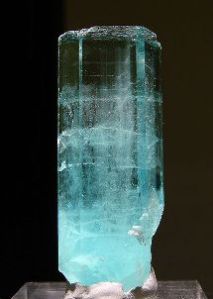Legend has it that aquamarine was originally found in the treasure chests of mermaids. Since ancient times sailors have considered this beautiful pale blue to blue-green stone to be lucky.
Lucky or not, aquamarine is a popular stone for jewelry. The hardness of the stone (7.5 – 8.0 on Moh’s scale of hardness) and its resistance to scratches, make it appropriate for use in most types of jewelry, including pieces that will be worn frequently.
Aquamarine is a member of the beryl family, along with its more famous cousin, emerald. The blue colour of aquamarine results from the presence of iron.
In the 19th and early 20th century, the preferred colour for aquamarine was sea green, but now sky blue and dark blue are preferred and more valuable.
Helpful hints if thinking of buying aquamarine (loose stones or finished jewelry):
- The value of aquamarine is linked to its colour. The more intense the colour, the higher the value of the stone.
- Natural aquamarine often has a green tint. This stone is often heat-treated to change the colour and make it bluer. Unless specified otherwise it is safe to assume that aquamarine is heat-treated. Heat-treating results in a permanent colour change.
- Aquamarine can be confused with blue topaz which has a similar colour, but is a less valuable stone.
- As aquamarines can be found as large stones the carat price should remain the same regardless of size for similar quality stones.
Lucky are those born in March, for this beautiful blue stone is their birth stone.




